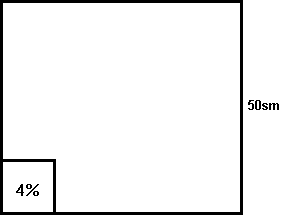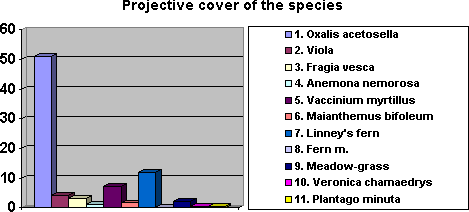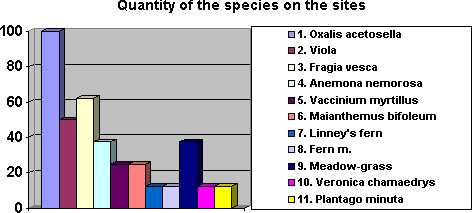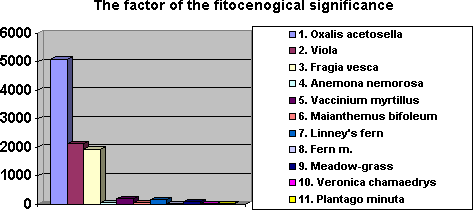
Fig.1. The border for the research of the projective cover
STUDY OF THE PLANT COMMUNITY OF THE FOREST-PARK ZONE OF GATCHINA TOWN
The performer of the project: Bukhvalov Yuriy (10 form), Dunaeva Olga (10 form), Konovalchik Tatiana (10 form), Secondary school, Taitsy settlement
The leaders of the project: Dunaeva I.N., Alekseeva Ì.Ì., Miroshkina S.M.
Introduction
The forest — is a natural steady formation of the vegetative coverage of extensive areas of globe taken until recently 1/3 surface of the land. Of all types of vegetation the forest renders on natural environment the greatest influence. It is exhibited in regulation of soil, hydrological and atmospheric processes. The forest plays one of major roles in maintenance of oxygen in atmosphere. The forests of the whole world annually reduce 55, 5 õ 106 ò of the oxygen.
It is well known, that in the spring in a forest the snow thaws slower, than on the fields, therefore thawed waters, gradually drain to the soil, create a reserve of ground waters.
The hydrological value of a forest is exhibited not only in accumulation of moisture in soil, but also in preventing the swamping of the land, because the tops of trees evaporate a great quantity of the moisture. Quite often the cutting of a forest in the close condition of the ground waters results to swamping of these territories. And, on the contrary, for dehumidifying of the swamped sites of the land people use the fast-growth species of the trees. The best desiccants of bogs — some species of the eucalyptus, which differ by fast growth and good evaporation.
The plants of the forest with microorganisms prevent an exhaustion of soil, promote for it’s improving of physical-chemical properties.
Because high-power development of root systems of the trees and plants, the forests promote also fastening of mobile sand in the southern-steppe and half-deserted regions. One of the main properties of a forest is it’s ability to reduce the solar radiation, going to the earth surface, because the part of energy of the sun is swallowed by plants at a photosynthesis, and other part is reflected from tops and leaves of the trees. At night the tops of trees hinder with return radiation from the earth surface. In this connection an air and soil under slanting forests in the day get warm less, than on the opened spaces, and summer temperature of an air in the forest is about 5 — 6 C° lower, than on a field. At night in a forest the air is cooled less. Thus, in a forest the diurnal oscillations of temperature are less, than on the opened spaces.
The forest promotes increase of relative humidity of the air. It is explained to that, at first, the tops of trees during a rain delay a part of deposits, which not at once fall in soil. Secondly, during habitability the leaves evaporate to the environment a great quantity of moisture. And, besides under tops of trees at lower temperature the evaporation from a surface of ground decreases on 15-30% on a comparison with opened space.
In epoch of the modern heavy development of production all over the world, presenting to contamination of the atmosphere harmful substances, especially valuable become ability of a forest to clear atmosphere from dust and gaseous substances. The researches have shown that the plants besiege on the surface up to 60 - 70 % of particles, suspended in an air, of dust, which then is washed off to the ground during a rain. For example, 1 hectare of oak filters with the tops 54 tons of the dust per one year, pine — 37 tons, fir — 30 ò (" Protection of a nature ", Mickheev A.V., Pashkang K.V., Rodzevich N.N., Soloviova M.P., under edition Pashkang Ê.V.).
In the beginning of our century a number of the scientists detected a valuable property of many kinds of forest plants — to select volatile substances (called fitoncidies), which are capable to kill a lot of ill microorganisms. Also forest has one more valuable property — ability to reduce force of a noise.
The value of the forest for a national economy is the very great. The forest is one of basic values of the state. But it becomes ever less. Each year in the world is destroyed more than 12 million hectares of the forest, and still about 10 million hectares of the forest are under degradation, because the cutting down of forests on these areas is not accompanied with environmental protection actions ("Biology", volume 3, Green, Stout, Tailor).
The problem of the degradation of the forests is actual for Russia. The special interest is represented with the tendencies of changing of the structure and conditions of the vegetative cover in conditions of a high-power antropogeneous load. The Leningrad region is located in a subzone of a southern taiga and before occurrence of the «antropogeneous factor» practically all of his non-swamped territory was covered with a forest. Now quantity of the forest in this region is 53 %, that is much lower, than in other regions of Northwest region ("Condition of the Environment of Northwest and Northern regions", 1995). In city and neighboring districts the vegetative world is secondary, human created i.e.
In conditions of an increasing antropogeneous load, barbarous maintenance of the forests and soils, the situation can be worsened and further. Only knowledge of regularities happening in forest ecosystems, and care of them can help to their recovery and survival, therefore study of a forest is very important problem.
The place of the research we have selected in the forest-park zone of Gatchina town. Forest-park zone executes protective, sanitary and improving functions, and, therefore, has a large antropogeneous load.
The purpose of activity
The purpose of our activity was the description of the plant community of the mixed forest, definition of the name of association, evaluation of a role of the plants composing a community, field definitions of the soil type, the condition of soil in antropogeneous load.
Course of activity
The activity we have begun from selection of a characteristic site of a forest
with the trial area 20õ20 m. The description of community we have begun from
the description of the tiers. We detected the following tiers:
I-forest, II- bush, III- herb-bush, IV - moss-lichen.
In the forest tier the quantity of various kinds of trees was calculated, and on the portion of each tree we made the formula of the forest — 6F3A1B + A — 60 % of the fir, 30 % of a mountain ash, 10 % of a birch and < 10 % of an aspen.
Further we have conducted the description of the herb-bush tier. It we conducted with a frame method, with the description of projective cover. The projective cover is that part of a plane of a surface of soil, which is covered with plants. On this territory by us was investigated and described eight sites. The results of the description are adduced below in the Table 1.
50 sm

Fig.1. The border for the research of the projective cover
Table 1
The description of the sites of the plant community
| Species | Strength | Phenophase | |
|---|---|---|---|
| Site ¹ 1 | |||
| 1. | Oxalis acetosella | 70% | = |
| 2. | Viola | 25% | + |
| 3. | Fragia vesca | 4% | - |
| 4. | Anemona nemorosa | 2% | |
| Site ¹ 2 | |||
| 1. | Oxalis acetosella | 80% | = |
| 2. | Fragia vesca | 4% | ^ |
| 3. | Vaccinium myrtillus | 8% | É |
| Site ¹ 3 | |||
| 1. | Oxalis acetosella | 50% | = |
| 2. | Fragia vesca | 5% | ^ |
| 3. | Maianthemus bifoleum | 10% | |
| 4. | Fern m. | 2% | |
| Site ¹ 4 | |||
| 1. | Oxalis acetosella | 40% | = |
| 2. | Vaccinium myrtillus | 50% | É |
| 3. | Viola | 5% | ^ |
| 4. | Fragia vesca | 2% | ^ |
| 5. | Poa annua | 2% | |
| Site ¹ 5 | |||
| 1. | Oxalis acetosella | 80% | = |
| 2. | Fragia vesca | 10% | Î |
| 3. | Viola | 2% | ^ |
| 4. | Veronica chamaedrys | 5% | ^ |
| 5. | Anemona nemorosa | 3% | ^ |
| 6. | Maianthemus bifoleum | 4% | |
| Site ¹ 6 | |||
| 1. | Plantago minuta | 4% | |
| 2. | Oxalis acetosella | 7% | = |
| 3. | Poa annua | 10% | |
| Site ¹ 7 | |||
| 1. | Gymnocarpium dryopteris | 95% | |
| 2. | Poa annua | 5% | |
| 3. | Oxalis acetosella | 4% | = |
| Site ¹ 8 | |||
| 1. | Oxalis acetosella | 80% | = |
| 2. | Viola | 2% | ^ |
| 3. | Anemona nemorosa | 5% | ^ |
= Secondary vegetation
+ Green fruits
— The plants is under vegetation, are in stage of the socket, beginning to give a stalk
^ The plant has thrown out a stalk or arrow and are appreciable burgeon
É Plant in stage of the beginning of the blossom, there
have first burgeon
Î The plant is in full blossom.
Further we have calculated the factor of the plant community’s significance (F.P.C.S.). This factor is calculated with the formula F.P.C.S. =X x R, where R is the per sent of meeting of kind from all sites, and X — means projective cover (see: a Table 2, Schedule 1, Schedule 2, Schedule 3).
Table 2
The factor of the plant community’s significance
| Species | X - Average projective cover | Quantity R, % | F.P.C.S. |
|---|---|---|---|
| 1. Oxalis acetosella | 51 | 100 | 5100 |
| 2. Viola | 4, 25 | 50 | 2120 |
| 3. Fragia vesca | 3, 125 | 62 | 1930 |
| 4. Anemona nemorosa | 1, 25 | 37, 5 | 46 |
| 5. Vaccinium myrtillus | 7, 25 | 25 | 181 |
| 6. Maianthemus bifoleum | 1, 75 | 25 | 43 |
| 7. Linney's fern | 11, 875 | 12, 5 | 148 |
| 8. Fern m. | 0, 25 | 12, 5 | 3 |
| 9. Poa annua | 2, 125 | 37, 5 | 79 |
| 10. Veronica chamaedrys | 0, 625 | 12, 5 | 7 |
| 11. Plantago minuta | 0, 5 | 12, 5 | 6 |
Shedule 1

Shedule 2

Shedule 3

From the analysis of a table it is visible, that most plant community’s significant kind in this community is the shamrock ordinary.
Then we described a specific structure, it an abundance and plant community’s condition of kinds, which were met on our site (see. Table 3).
Table 3
The quantity of the species in researched site
| The kind | Name of the plant | Phenophase | The crop |
|---|---|---|---|
| Rosaceaeå | 1. Ceum rivale | Ñ, + | Sp |
| 2. Fragia vesca | Î | sp | |
| 3. Potentilla erecta | - | rr | |
| 4. Alchemilla | - | sp | |
| 5. Rubus saxatilis | Ñ | cop1 gr | |
| Geraniaceae | 6. Geranium silvaticum | Î | sp |
| Plantaginaceae | 7.Plantago minuta | - | rr |
| Lbiatae | 8. Caleobdolon Cuteum | rr | |
| Caryophyllacea | 9. Stellaria nemorum | rr | |
| 10. Stellaria graminea | rr | ||
| Onagraceae | 11. Chamaenerion angystfolium | - | rr |
| Umbelliferae | 12. Ahthriscus silvestris | Î | Sol |
| 13. Aegopodium polagraria | - | sol | |
| Oxalidaceae | 14. Oxalis acetosella | = | cop3 |
| Ranunculaceae | 15. Actaea spicata | + | rr |
| 16. Ranunculus acer | Î | sol | |
| 17. Anemona nemorosa | + | sol | |
| Primulaceae | 18. Trientalis europeaea | Ñ | cop1 gr |
| Vacciniacea | 19. Vaccinium myrtillus | - | sp |
| Liliaceae | 20. Maianthemus bifoleum | = | sol |
| 21. Paris guadrifolia | + | sol | |
| Violaceae | 22. Viola | + | cop2 |
| 23. Viola mirabilis | + | rr | |
| Scrophulariaceae | 24. Veronica chamaedrys | Î | sol |
| 25. Veronica afficinalis | Î | sol | |
| Urticaceae | 26. Urtica dioica | - | un |
| Guttiferae | 27. Hypericum perforatium | - | rr |
| Compositae | 28. Tussilago farfata | = | rr |
| 29. Taraxatum officinale | - | rr | |
| 30. Hieiacium | sol | ||
| Pyrolaceae | 31. Pyrola L. | Î | rr |
| Cyperaceae | 32. Carex Pallescens | - | sol |
| Gramineae | 33. Poa annua | - | sp |
| Polypodiacae | 34. Dryopteris filix-mas | cop1 | |
| 35. Gymnocarpium dryopteris | Sp | ||
| 36. Athyrium |
Moss-lichen tier is submitted by the following kinds of mosses: Polia, Mnie m., Plaliotecie, Gilocomie. We haven’t met ground lichens. Among inhabitants of the moss-lichen tier we have met 1 bug - cracker, 1 norfolk howard, 6 bugs - infants, 5 spiders, 1 larva of butterfly and 5 rainy worms.
During of our activity we have defined the names of plants of base vegetative association: birch-rowan fir-forest with shamrock. A plant-edificator is the firtree. It creates strong blackout, and under it slanting exist only enough shadow-wiry plants. Among plants, it is a lot of such, which have white flowers — wild strawberry, asterisk oakery, shamrock, anemone etc. — this adaptation for poor light in conditions of a fir-tree forest. Many plants of a firtree forest are long-term, at majority have a long rambling roots or underground scions, capable fast to expand in legs and to seize the new area, all this — adaptation for specific conditions under slanting fir-forest. Some plants, for example, Pyrola L., sedge remain green for winter, and Maianthemus bifoleum and Trientalis europeaea have a winter only as underground organs. Glues very much shadow-wiry of a plant, they well transfer mechanical effect from needles, dropping from trees.
On a degree of the treading of the given site concerns to II class (tracks are tramped). By conducting researches lichens, we have detected the following kinds:
Using a table the express train - evaluation of contamination of an air on lichens is possible to make a conclusion, that an air rather pure.
To evaluate quality of soil on our site, we incorporated a soil sectional view.
Table 4
The description of genetic horizons of a section view of the soil
| Àî 0-2 | Forest litter - Texture of the radicals of grass, trees, bushes with moss cover and small contents of the mineral matters. In the litter w have found the rather big quantity of the leaves and coniferous fir-needles. |
| À1 2-17 | Horizon is characterized on color as grey - brown, on a structure - cloggy -granular, on a mechanical structure - easy clayey soil, on humidity - humid, on density - quite compact. Contains many radicals. Transition to the following horizon is gradual. The tracks' ways of the worms are full of the material from the following horizont. |
| ÂÑ 17-28 | The horizon is characterized on color as light brown, on a structure - cloggy-granular, on the mechanical structure - average clayey soil, on humidity - humid, on density - compact. Transition in the following horizon - gradual. |
| B | Underlying rock - carbonic moraines |
In the field conditions the soil was determined as sod - carbonic leached easy-loamy on carbonic moraines.
Also we conducted the chemical express - analysis of soil from humus horizon on the device for the express - control of a water and soil objects "Pchelka" on pH, active Cl, Fe2+, Fe3 +, nitrates, nitrites, sulfides (including hydrosulfide anions), Cu, Ni. No one of these parameters did not exceed maximum permissible concentration. As a result of the chemical analysis we can say the soil not polluted.

Fig. 2. Schematic Figures of a structure of the researched site
Sod - carbonic differ of the more high level of fertility, and, as is known, on more fertile soils in Fir-forest the solid cover of the shamrock develops.
Variety of climatic conditions, vegetation, mountain rocks, relief, various age of separate territories cause also variety of soils in a nature. The geographical regularities of their distribution are determined by a combination of the factors of soil formation. For globe and continents, separate it, these regularities are connected to zone changes of a climate and vegetation and express in development of horizontal and vertical ash values of soils. The singularities of a soil cover of small territories are connected, first of all, to influence of a relief, structure and properties of rocks on a climate, soils, vegetation, soil formation. Such connections and correlation of the various factors of the soil formation confirms a known thesis by V.V. Dokuchaev — "The soil is a function of environment" ("A practical Work on field edaphology (on natural zones)").
The soils which are not similar to zone soils — sod-carbonic soils, formed on carbonic moraines maternal rocks are characteristic of our district (namely, for Ordovic plateau). Due to the large contents of organic substances, mobile and available for the plants phosphorus and potassium and carbonate of calcium, sod-carbonic soil are more fertile, than zone of sod-ash soil. For this reason, and also due to a rather favorable climate, these soils since old times were used by the human in the agriculture, and in present the reclamation of these lands is approximately 30 % (average in the region — Less than 10 %). Distinguish three types of the sod-carbonic soils:
Sod-carbonic typical soils are formed in case of close bedding of the carbonic plate or on hard carbonic moraines and take, as a rule, increased sites of a relief. Sod-carbonic leached soil are formed on less carbonic and more high-power moraine and take mean sites of hills. Sod-carbonic ashed soil take the flat sites of a relief and reduced, where the additional washing by waters of a surface drain is possible, usually meet in a complex with other subtypes sod-carbonic soils.
Conclusions and proposals
The degree of contamination of our site in conditions of antropogeneous load was evaluated with degree of the trampling, contamination of atmosphere — with the method of the lichen indication, contamination of soil — with the chemical express - analysis on the device for the express - control "Pchelka". By conducting researches, we have found out, that, despite of a rather high degree of an antropogeneous load, the degree of contamination of this site rather small, this ecosystem is rather steady, has good regulation system which is capable to execute the protective, sanitarian and improving functions. Our main task is to look at this ecosystem, that the antropogeneous load to the ecosystem wount be so high, to watch, that there were no cuttings down trees, unauthorized dumps, campfires, walk of the cattle, etc. For this purpose it is necessary to transmit information, obtained by us, to the administration of Gatchina town, and also to make the control of the condition of this forest-park zone.
| Ïåðåéòè ê îãëàâëåíèþ |  |
|||||
 | ||||||
|
|
|
|||||